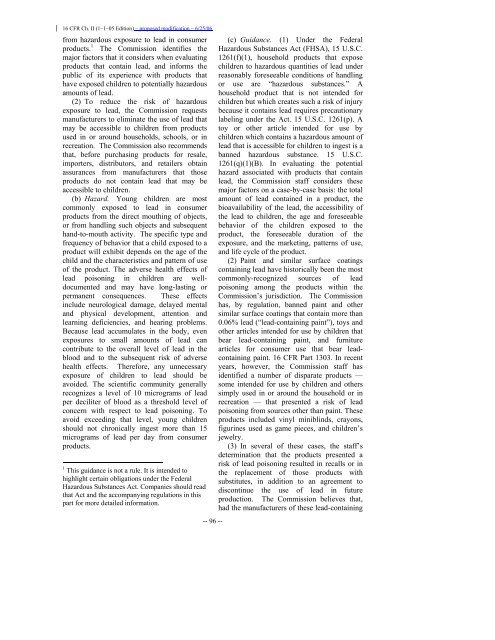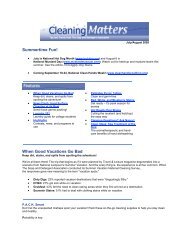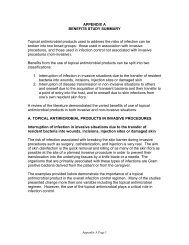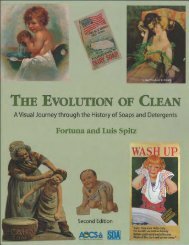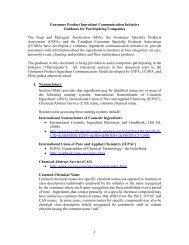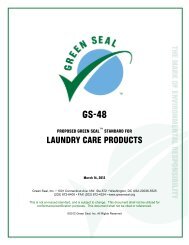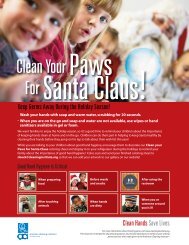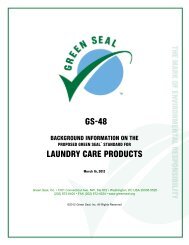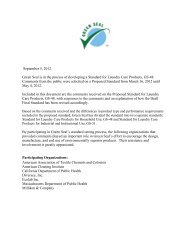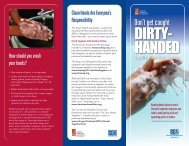subchapter c -- federal hazardous substances act regulations
subchapter c -- federal hazardous substances act regulations
subchapter c -- federal hazardous substances act regulations
You also want an ePaper? Increase the reach of your titles
YUMPU automatically turns print PDFs into web optimized ePapers that Google loves.
16 CFR Ch. II (1–1–05 Edition) – proposed modification – 6/25/06<br />
from <strong>hazardous</strong> exposure to lead in consumer<br />
products. 1 The Commission identifies the<br />
major f<strong>act</strong>ors that it considers when evaluating<br />
products that contain lead, and informs the<br />
public of its experience with products that<br />
have exposed children to potentially <strong>hazardous</strong><br />
amounts of lead.<br />
(2) To reduce the risk of <strong>hazardous</strong><br />
exposure to lead, the Commission requests<br />
manuf<strong>act</strong>urers to eliminate the use of lead that<br />
may be accessible to children from products<br />
used in or around households, schools, or in<br />
recreation. The Commission also recommends<br />
that, before purchasing products for resale,<br />
importers, distributors, and retailers obtain<br />
assurances from manuf<strong>act</strong>urers that those<br />
products do not contain lead that may be<br />
accessible to children.<br />
(b) Hazard. Young children are most<br />
commonly exposed to lead in consumer<br />
products from the direct mouthing of objects,<br />
or from handling such objects and subsequent<br />
hand-to-mouth <strong>act</strong>ivity. The specific type and<br />
frequency of behavior that a child exposed to a<br />
product will exhibit depends on the age of the<br />
child and the char<strong>act</strong>eristics and pattern of use<br />
of the product. The adverse health effects of<br />
lead poisoning in children are welldocumented<br />
and may have long-lasting or<br />
permanent consequences. These effects<br />
include neurological damage, delayed mental<br />
and physical development, attention and<br />
learning deficiencies, and hearing problems.<br />
Because lead accumulates in the body, even<br />
exposures to small amounts of lead can<br />
contribute to the overall level of lead in the<br />
blood and to the subsequent risk of adverse<br />
health effects. Therefore, any unnecessary<br />
exposure of children to lead should be<br />
avoided. The scientific community generally<br />
recognizes a level of 10 micrograms of lead<br />
per deciliter of blood as a threshold level of<br />
concern with respect to lead poisoning. To<br />
avoid exceeding that level, young children<br />
should not chronically ingest more than 15<br />
micrograms of lead per day from consumer<br />
products.<br />
1 This guidance is not a rule. It is intended to<br />
highlight certain obligations under the Federal<br />
Hazardous Substances Act. Companies should read<br />
that Act and the accompanying <strong>regulations</strong> in this<br />
part for more detailed information.<br />
-- 96 --<br />
(c) Guidance. (1) Under the Federal<br />
Hazardous Substances Act (FHSA), 15 U.S.C.<br />
1261(f)(1), household products that expose<br />
children to <strong>hazardous</strong> quantities of lead under<br />
reasonably foreseeable conditions of handling<br />
or use are “<strong>hazardous</strong> <strong>substances</strong>.” A<br />
household product that is not intended for<br />
children but which creates such a risk of injury<br />
because it contains lead requires precautionary<br />
labeling under the Act. 15 U.S.C. 1261(p). A<br />
toy or other article intended for use by<br />
children which contains a <strong>hazardous</strong> amount of<br />
lead that is accessible for children to ingest is a<br />
banned <strong>hazardous</strong> substance. 15 U.S.C.<br />
1261(q)(1)(B). In evaluating the potential<br />
hazard associated with products that contain<br />
lead, the Commission staff considers these<br />
major f<strong>act</strong>ors on a case-by-case basis: the total<br />
amount of lead contained in a product, the<br />
bioavailability of the lead, the accessibility of<br />
the lead to children, the age and foreseeable<br />
behavior of the children exposed to the<br />
product, the foreseeable duration of the<br />
exposure, and the marketing, patterns of use,<br />
and life cycle of the product.<br />
(2) Paint and similar surface coatings<br />
containing lead have historically been the most<br />
commonly-recognized sources of lead<br />
poisoning among the products within the<br />
Commission’s jurisdiction. The Commission<br />
has, by regulation, banned paint and other<br />
similar surface coatings that contain more than<br />
0.06% lead (“lead-containing paint”), toys and<br />
other articles intended for use by children that<br />
bear lead-containing paint, and furniture<br />
articles for consumer use that bear leadcontaining<br />
paint. 16 CFR Part 1303. In recent<br />
years, however, the Commission staff has<br />
identified a number of disparate products —<br />
some intended for use by children and others<br />
simply used in or around the household or in<br />
recreation — that presented a risk of lead<br />
poisoning from sources other than paint. These<br />
products included vinyl miniblinds, crayons,<br />
figurines used as game pieces, and children’s<br />
jewelry.<br />
(3) In several of these cases, the staff’s<br />
determination that the products presented a<br />
risk of lead poisoning resulted in recalls or in<br />
the replacement of those products with<br />
substitutes, in addition to an agreement to<br />
discontinue the use of lead in future<br />
production. The Commission believes that,<br />
had the manuf<strong>act</strong>urers of these lead-containing


